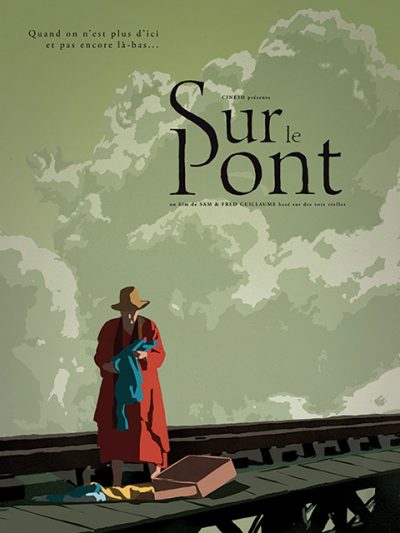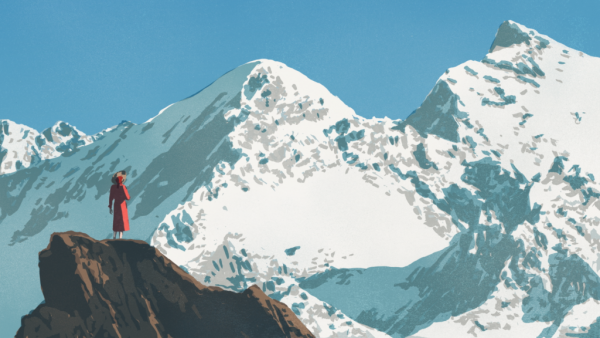‘On the Bridge’ explores the transition from life to death and beyond

“On the Bridge” (“Sur le Pont”) (2022). Directors: Samuel Guillaume and Frédéric Guillaume. Web site. Trailer.
In essence, a group of individuals at a remote train station await a mysterious outbound departure to an unknown destination. The station is largely empty, yet the space has a palpable air of anxious foreboding about it. Nevertheless, the passengers all seem quietly reconciled to their circumstances, despite the inherent uncertainty. Before long, they board the outgoing train, each settling into their quarters or in the various common areas. And, as they do so, they begin to express their thoughts and feelings about this experience, recorded observations drawn from the aforementioned interviews. Some try to understand why they’re here; others talk about their hopes, fears and visions, with some sharing memories about their lives. But no one really knows where he or she is headed on this mysterious journey until they reach what appears to be their mutual destination – a suspension bridge over a river, one presumably spanning heaven and earth.
Upon reaching the bridge, however, their goal still remains unclear – what are they supposed to do now that they’ve arrived at this place, especially when the train inexplicably stops halfway across the span? Are they supposed to make their way to the other side? And, if so, what awaits them there? But how are they supposed to accomplish this task when there’s no way to safely exit the train and walk across the tracks? That’s a prospect made even more difficult when the trestles begin to weaken and falter as the bridge starts to collapse, eventually falling into the river below. So what’s next?

As events further unfold, the passengers who started out on this journey together each find themselves in different locales, all of them vibrantly beautiful, even if each is different in character and appearance. But where exactly are they? Is this “heaven”? If so, why aren’t the various venues the same? Could it be that heaven is a relative place? And, if so, how did that happen?
Although the film is built on real testimonies, the project is purely fictional, even if the various impressions depicted here are the products of each individual’s personal conjectures about what awaits them. The filmmakers made it possible for the interview subjects to freely express their feelings (regardless of how truthful, sincere or lucid they were at the time of their conversations) by portraying them here with anonymous animated doubles. And, even though all of the seniors have since passed on, their insights remain in this cinematic record, giving us all food for thought on a question related to the only common fate we all share.

If the foregoing is indeed as true as it seems to be, then, doesn’t it seem likely that the same principle that underlies the manifestation of physical reality would also apply to the creation of any form of existence, including one that constitutes the afterlife? After all, if our consciousness is a common element of both forms of reality, then wouldn’t the components that constitute it – our beliefs – be present in both realms as well? And, by extension, wouldn’t their function also be the same in both cases – the materialization of the ensuing reality? And, going one step further, if our individual beliefs each manifest the existence we experience, wouldn’t it make sense that each of those realities would be separate and distinct from one another, tailored to what we believe, whether we’re talking about the earthly or heavenly planes? (Seems like a reasonable enough assumption to me.)
As this film illustrates, that’s what would account for one individual believing that the afterlife is a beautiful seashore with a gorgeous white sand beach, while, for someone else, it’s a stunning mountain peak. Both are conceivable forms of a heavenly existence, even if their appearances differ widely; they just happen to be tailored to accommodate the beliefs, expectations, impressions and desires of those materializing them. In that sense, one could be wont to say, “Now that’s heaven!”
Given how the manifestation process works, it’s not surprising that each iteration is separate, distinct and different considering one of the key principles that underlies this philosophy – the idea that everything is in a constant state of becoming. Like the ever-changing patterns that appear in a glass kaleidoscope, the same is true in the creation of the reality we experience, regardless of which plane of existence on which it occurs. That notion would, in turn, seem to verify the widely held contention that variety is indeed the spice of life (or existence), regardless of where it unfolds. This film offers further evidence of that.

The picture’s use of the train as an image for illustrating that concept is a perfect metaphor, too. A train travels down a particular set of tracks, an apt symbol of a specific line of probability, with a specific destination (or outcome) in mind. It’s just one of an infinite number present in the universal pool of possibilities. As the passengers aboard the train here travel down those tracks, they’re each headed down a particular line of probability, one governed by their respective manifestation beliefs. It’s a perfect way to depict how these events play out, and it’s one that’s been used both visually and verbally in a variety of other narratives, from movies like “Defending Your Life” (1991) and “Stardust Memories” (1980) to television shows like The Golden Girls to the musings of departed loved ones recorded in alleged after-death journals. Indeed, punching our ticket could prove to be a notion that’s almost as literal as it is figurative.
If we understand this process as thoroughly as it’s depicted here, we might assume that such an awareness could help us to be more proficient at putting it to use when the time comes, aiding us in manifesting an afterlife experience that comes closest to achieving what we hope for. That, in essence, could be seen as a way to more effectively live out our destiny. And, in light of that, what better way would there be to make our transition to the next step than that? Talk about traveling in comfort and style!
Even though the filmmakers contend that this production is a purely fictional exercise, it’s fascinating to note how many of its principles are readily reflected in many of the world’s spiritual, religious, philosophical and metaphysical texts. Indeed, if these principles come up as often as they appear to and this film faithfully echoes them, then maybe there’s something to them – and worth listening to. After all, who would want to squander an opportunity like this, especially when it offers us the chance to attain for ourselves exactly what we want? Sounds like a pretty good deal to me.

What exactly happens at the end of life? As we transition from this world to whatever comes next, what can we realistically expect? And how long does the process take – if time even means anything at that point? That’s what this insightful and fascinating animated documentary seeks to capture, combining the insights and speculation of individuals at the end of life. Their observations span the spectrum of topics, with moods ranging from ennui to hope to humor as they envision what’s ahead and how it will come into being during their fateful train ride. All of this is presented through stunningly gorgeous animation backed by an ethereal score and, of course, the narrated reflections of the wayfarers making their final pilgrimages. Directors Samuel and Frédéric Guillaume have created a beautifully moving, eminently enlightening work that’s positively striking to look at. This is essential viewing for anyone who wonders what comes at the end of the line and how to properly prepare for it. If you’re not profoundly touched by this offering, I don’t know what will.
Unfortunately, this film is somewhat difficult – though not impossible – to find, having largely played the festival circuit. However, in an effort to make their work more widely available, the filmmakers have augmented the project in book form published by Faim de Siècle editions. Besides providing additional insights on the subject, the printed version provides readers with access to the film and its bonus features via a QR code. Author Josiane Haas and illustrator Frédéric Guillaume give the floor to men and women who rub shoulders with death on a daily basis, including a former cemetery gardener, a housekeeper in palliative care, an embalmer, a theater actor and a funeral photographer. The book is thus a living collection of insights into the subject matter in a way that, ironically, brings it to life in a rich and colorful way. The book is available in bookstores and on the publisher’s website.
Copyright © 2022-2023, by Brent Marchant. All rights reserved.



